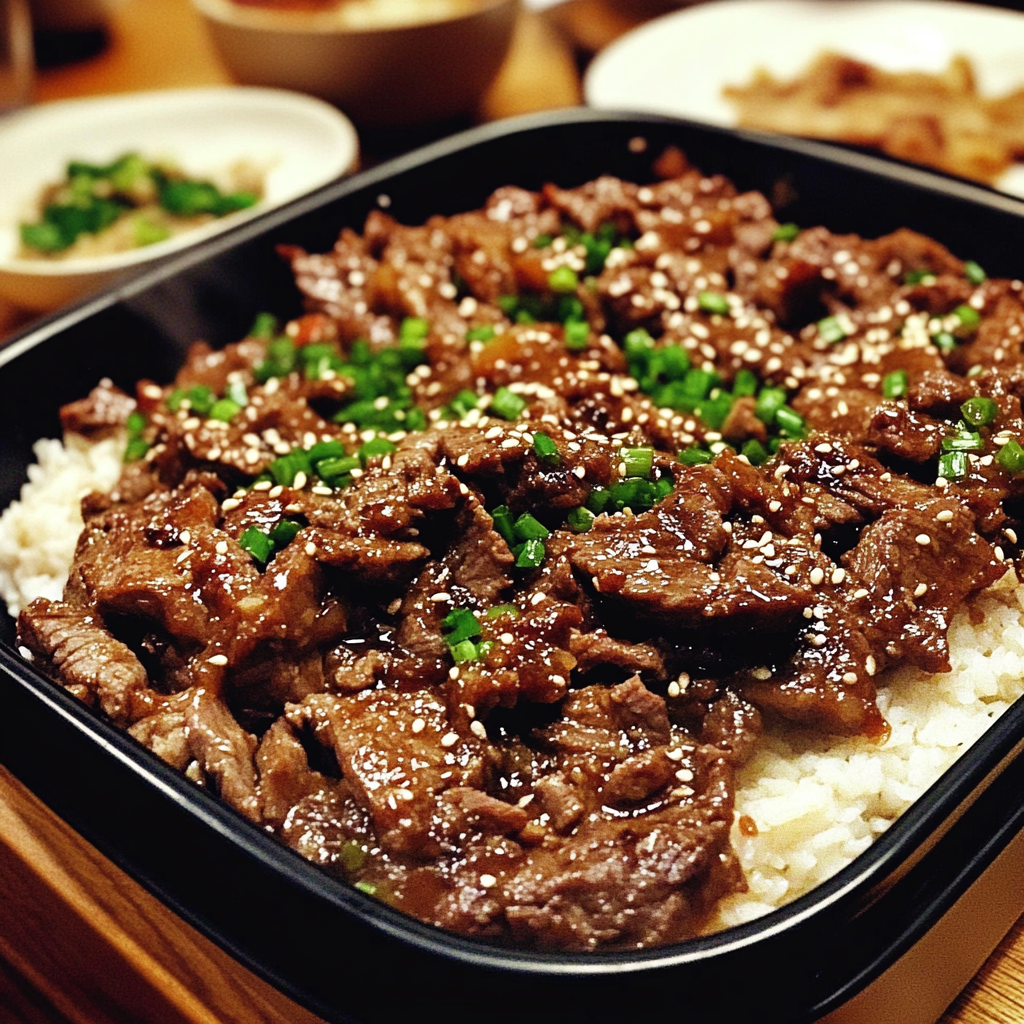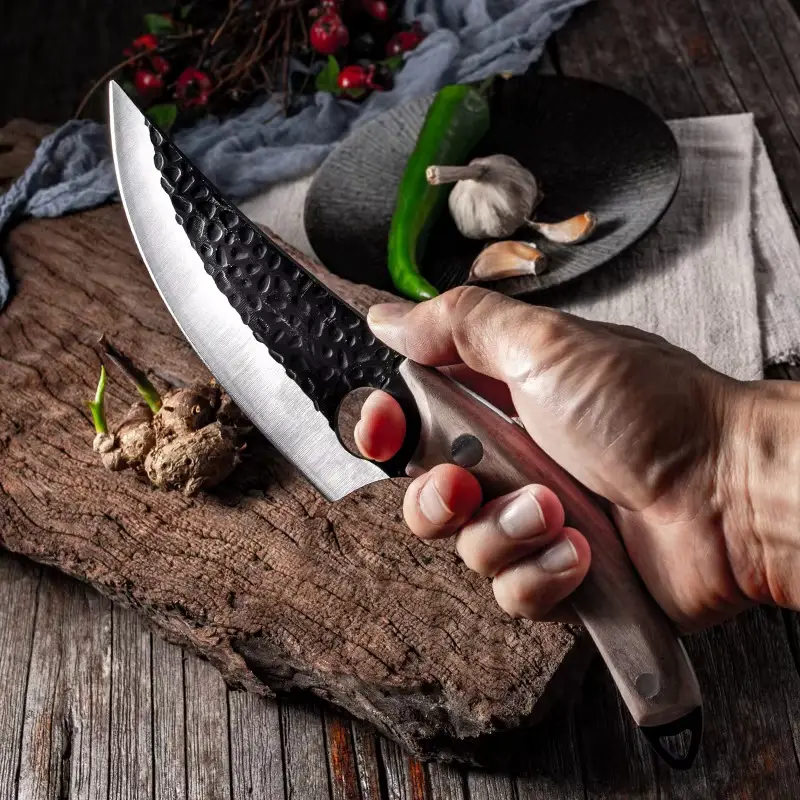Korean Beef Bulgogi (불고기), which translates to “fire meat,” is one of Korea’s most famous and beloved dishes. This savory-sweet grilled beef dish has a deep history and a flavor profile that captures the essence of Korean cuisine. Thin slices of beef are marinated in a blend of soy sauce, sugar, garlic, sesame oil, and fresh ginger, creating a balance of salty, sweet, and nutty flavors that make it absolutely irresistible. Traditionally cooked over an open flame, bulgogi can also be prepared in a skillet, grill pan, or even a barbecue grill, making it versatile and accessible for home cooks. Whether you’re serving it over rice, wrapped in lettuce leaves, or as part of a Korean barbecue spread, beef bulgogi is a dish that never fails to impress. Let’s dive into this authentic and mouthwatering recipe.
Why You’ll Love This Recipe
- Quick and Easy: With minimal prep time and simple ingredients, this dish comes together quickly for a flavorful meal.
- Incredibly Flavorful: The marinade infuses the beef with a perfect balance of salty, sweet, and umami flavors.
- Versatile: Bulgogi can be served as a main dish, in tacos, on top of salads, or even in sandwiches.
- Great for Entertaining: Whether you’re hosting a Korean BBQ night or a casual dinner, this dish is a guaranteed crowd-pleaser.
- Kid-Friendly: The mild sweetness of bulgogi makes it appealing to both kids and adults.
- Customizable: You can easily adapt the recipe with different cuts of beef, vegetables, or spice levels to suit your preferences.
Preparation Time and Servings
- Prep Time: 15 minutes (plus 30 minutes to 24 hours for marinating)
- Cook Time: 10 minutes
- Total Time: 25 minutes (excluding marinating time)
- Yield: 4 servings
- Serving Size: Approximately 1 cup of bulgogi
Nutritional Information (per serving)
- Calories: 320
- Carbohydrates: 12g
- Protein: 28g
- Fat: 18g
- Fiber: 1g
- Sugar: 9g
Ingredients
For the Marinade:
- 1/3 cup low-sodium soy sauce
- 2 tablespoons brown sugar
- 1 tablespoon honey
- 1 tablespoon sesame oil
- 3 garlic cloves, minced
- 1 tablespoon fresh ginger, grated
- 1/4 teaspoon black pepper
- 1/2 small onion, grated (or blended)
- 1 tablespoon mirin (rice wine) (optional)
For the Bulgogi:
- 1 pound ribeye steak or sirloin, thinly sliced against the grain
- 1 small carrot, julienned (optional)
- 1 small onion, thinly sliced
- 2 green onions, chopped
- 1 tablespoon sesame seeds (for garnish)
- Vegetable oil, for cooking
Optional Accompaniments:
- Steamed rice
- Lettuce leaves (for wrapping)
- Kimchi
- Sliced cucumber or pickled radish
Step-by-Step Instructions
Step 1: Prepare the Beef
Place the ribeye or sirloin steak in the freezer for 15-20 minutes. This makes it easier to slice the meat thinly. Once chilled, use a sharp knife to slice the beef into thin strips, cutting against the grain for maximum tenderness.
Step 2: Make the Marinade
In a large mixing bowl, combine the soy sauce, brown sugar, honey, sesame oil, garlic, ginger, black pepper, grated onion, and mirin (if using). Whisk until the sugar is dissolved and the ingredients are well blended.
Step 3: Marinate the Beef
Add the sliced beef to the marinade, making sure each piece is fully coated. Cover the bowl with plastic wrap and refrigerate for at least 30 minutes, or up to 24 hours for a more intense flavor.
Step 4: Prepare the Vegetables
While the beef marinates, slice the onion, julienne the carrot, and chop the green onions. Set aside.
Step 5: Cook the Bulgogi
Heat a large skillet or grill pan over medium-high heat and drizzle with a bit of vegetable oil. Once hot, add the marinated beef in a single layer, making sure not to overcrowd the pan. Cook for 2-3 minutes per side, or until browned and cooked through. Add the sliced onions and carrots during the last few minutes of cooking, tossing everything together until the vegetables are slightly softened.
Step 6: Garnish and Serve
Transfer the cooked bulgogi to a serving platter. Garnish with chopped green onions and sesame seeds. Serve hot with steamed rice, lettuce leaves for wrapping, or any of your favorite Korean side dishes.
Ingredient Background
- Ribeye or Sirloin: These tender cuts of beef are ideal for bulgogi. Ribeye has more marbling, making it juicier and more flavorful, while sirloin is a leaner option.
- Soy Sauce: The foundation of the marinade, soy sauce provides a savory umami flavor that complements the sweetness of the honey and brown sugar.
- Sesame Oil: A staple in Korean cuisine, sesame oil adds a nutty aroma and depth of flavor to the dish.
- Grated Onion: Blending or grating the onion releases its natural sweetness, which enhances the marinade and tenderizes the beef.
- Mirin: A sweet rice wine that adds complexity to the marinade. If unavailable, you can substitute with a splash of rice vinegar and a teaspoon of sugar.
Technique Tips
- Slice Against the Grain: Cutting the beef against the grain ensures tender, melt-in-your-mouth bites.
- Use High Heat: Cooking over high heat allows the beef to caramelize quickly, locking in its juices and creating a delicious charred flavor.
- Don’t Overcrowd the Pan: Cook the beef in batches if necessary to ensure even browning. Overcrowding will cause the meat to steam rather than sear.
- Marinate Overnight for Best Results: While 30 minutes is sufficient, marinating the beef for several hours or overnight allows the flavors to fully penetrate the meat.
Alternative Presentation Ideas
- Bulgogi Bowls: Serve the beef over steamed rice and top with shredded carrots, cucumbers, kimchi, and a soft-boiled egg for a bibimbap-style meal.
- Lettuce Wraps: Wrap the bulgogi in crisp lettuce leaves with a dollop of gochujang (Korean chili paste) for a fresh and flavorful appetizer.
- Bulgogi Tacos: Use the beef as a filling for tacos, paired with pickled vegetables and a drizzle of spicy mayo.
- On Noodles: Toss the cooked bulgogi with udon noodles or rice noodles for a hearty and satisfying dish.
Additional Tips for Success
- Freeze Leftovers: Bulgogi freezes well, so you can make a double batch and save some for later. Thaw and reheat in a skillet for a quick meal.
- Use a Mandoline for Uniform Slicing: A mandoline makes it easy to achieve thin, even slices of beef and vegetables.
- Balance Sweetness: Adjust the sugar or honey in the marinade to suit your taste preferences.
- Try a Cast-Iron Pan: Cooking bulgogi in a cast-iron pan helps achieve a great sear and enhances the smoky flavor.
Recipe Variations
- Spicy Bulgogi: Add 1-2 tablespoons of gochujang to the marinade for a spicy kick.
- Chicken Bulgogi: Substitute the beef with thinly sliced chicken thighs or breasts.
- Pork Bulgogi: Use thinly sliced pork shoulder and adjust the sweetness in the marinade slightly.
- Vegan Bulgogi: Replace the beef with tofu or seitan and use a plant-based soy sauce substitute for a vegan-friendly version.
Freezing and Storage
- To Store: Place leftover bulgogi in an airtight container and refrigerate for up to 4 days.
- To Freeze: Transfer cooled bulgogi to a freezer-safe bag or container. Freeze for up to 3 months.
- To Reheat: Reheat in a skillet over medium heat until warmed through. Avoid microwaving, as it may overcook the beef.
Healthier Twist Ideas
- Use leaner cuts of beef like sirloin to reduce fat content.
- Replace brown sugar with a natural sweetener like honey or maple syrup.
- Serve with cauliflower rice or whole-grain brown rice instead of white rice.
- Add more vegetables, such as bell peppers, zucchini, or mushrooms, to boost the dish’s nutritional value.
Serving Suggestions for Events
- Korean BBQ Night: Pair bulgogi with other grilled dishes like samgyeopsal (pork belly) and kalbi (short ribs) for an authentic Korean BBQ experience.
- Family Dinner: Serve alongside steamed rice, kimchi, and a variety of banchan (Korean side dishes) for a complete meal.
- Party Platter: Arrange the bulgogi on a large platter with lettuce wraps, pickled vegetables, and dipping sauces for a fun and interactive appetizer.
- Lunchboxes: Pack leftover bulgogi with rice and steamed vegetables for a flavorful, protein-packed meal on the go.
Special Equipment
- Mandoline or Sharp Knife: Essential for slicing the beef thinly and evenly.
- Cast-Iron Skillet or Grill Pan: Ideal for achieving a smoky, charred flavor.
- Mixing Bowl: For preparing and marinating the beef.
Frequently Asked Questions
Q: Can I make bulgogi without a grill?
A: Yes, a skillet or grill pan works perfectly for cooking bulgogi on the stovetop.
Q: What’s the best cut of beef for bulgogi?
A: Ribeye and sirloin are traditional choices due to their tenderness, but flank steak or brisket can also be used.
Q: Can I use pre-sliced beef?
A: Pre-sliced beef from an Asian grocery store is a convenient option, often labeled as “bulgogi beef.”
Q: How do I make bulgogi spicier?
A: Add gochujang or red pepper flakes to the marinade for extra heat.
Q: Can I marinate the beef for too long?
A: While overnight marinating enhances flavor, marinating for more than 24 hours can break down the meat too much and affect its texture.
Q: What sides go best with bulgogi?
A: Steamed rice, kimchi, pickled radishes, and seaweed salad are classic accompaniments.
Q: Is bulgogi gluten-free?
A: To make bulgogi gluten-free, use tamari or a gluten-free soy sauce alternative.
Q: Can I make bulgogi ahead of time?
A: Yes, marinate the beef up to a day in advance and cook it just before serving for the best flavor.
Conclusion
Korean Beef Bulgogi is a classic dish that brings the flavors of Korean cuisine to your kitchen with ease. The tender, marinated beef, infused with a sweet and savory sauce, is incredibly versatile and perfect for any occasion. Whether you’re hosting a Korean BBQ night or simply looking for a quick and flavorful dinner idea, this recipe delivers every time. With its irresistible aroma and melt-in-your-mouth texture, bulgogi is sure to become a favorite in your household. Try it today and savor the taste of Korea!
Print
Korean Beef Bulgogi
- Total Time: 25 minutes
- Yield: 4 servings 1x
Ingredients
For the Marinade:
- 1/3 cup low-sodium soy sauce
- 2 tablespoons brown sugar
- 1 tablespoon honey
- 1 tablespoon sesame oil
- 3 garlic cloves, minced
- 1 tablespoon fresh ginger, grated
- 1/4 teaspoon black pepper
- 1/2 small onion, grated (or blended)
- 1 tablespoon mirin (rice wine) (optional)
For the Bulgogi:
- 1 pound ribeye steak or sirloin, thinly sliced against the grain
- 1 small carrot, julienned (optional)
- 1 small onion, thinly sliced
- 2 green onions, chopped
- 1 tablespoon sesame seeds (for garnish)
- Vegetable oil, for cooking
Optional Accompaniments:
- Steamed rice
- Lettuce leaves (for wrapping)
- Kimchi
- Sliced cucumber or pickled radish
Instructions
Step 1: Prepare the Beef
Place the ribeye or sirloin steak in the freezer for 15-20 minutes. This makes it easier to slice the meat thinly. Once chilled, use a sharp knife to slice the beef into thin strips, cutting against the grain for maximum tenderness.
Step 2: Make the Marinade
In a large mixing bowl, combine the soy sauce, brown sugar, honey, sesame oil, garlic, ginger, black pepper, grated onion, and mirin (if using). Whisk until the sugar is dissolved and the ingredients are well blended.
Step 3: Marinate the Beef
Add the sliced beef to the marinade, making sure each piece is fully coated. Cover the bowl with plastic wrap and refrigerate for at least 30 minutes, or up to 24 hours for a more intense flavor.
Step 4: Prepare the Vegetables
While the beef marinates, slice the onion, julienne the carrot, and chop the green onions. Set aside.
Step 5: Cook the Bulgogi
Heat a large skillet or grill pan over medium-high heat and drizzle with a bit of vegetable oil. Once hot, add the marinated beef in a single layer, making sure not to overcrowd the pan. Cook for 2-3 minutes per side, or until browned and cooked through. Add the sliced onions and carrots during the last few minutes of cooking, tossing everything together until the vegetables are slightly softened.
Step 6: Garnish and Serve
Transfer the cooked bulgogi to a serving platter. Garnish with chopped green onions and sesame seeds. Serve hot with steamed rice, lettuce leaves for wrapping, or any of your favorite Korean side dishes.
- Prep Time: 15 minutes
- Marinating Time: 30 minutes to 24 hours
- Cook Time: 10 minutes
Nutrition
- Serving Size: Approximately 1 cup of bulgogi
- Calories: 320
- Sugar: 9g
- Fat: 18g
- Carbohydrates: 12g
- Fiber: 1g
- Protein: 28g



